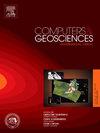Object segmentation of near surface magnetic field data based on deep convolutional neural networks
IF 4.2
2区 地球科学
Q1 COMPUTER SCIENCE, INTERDISCIPLINARY APPLICATIONS
引用次数: 0
Abstract
Near surface magnetic data contain valuable information on buried structures. Magnetic gradient tensor (MGT) can provide more detailed information than total magnetic intensity (TMI) and magnetic vectors. Traditional methods extract target-related features from magnetic data by identifying manually designed edge-features. These methods are either sensitive to changes in inclination and declination angles or have limited spatial resolution. This highlights the need for new approaches to accurately capture the complex details inherent in magnetic data. Although some studies have introduced machine learning techniques, their models often focus narrowly on identifying simple object shapes. Additionally, their models often overlook the potential of using MGT data directly as input, thereby missing the opportunity to fully utilize neural networks to interpret magnetic data. In this study, a deep convolutional neural network-based object segmentation method on MGT data was developed. We introduced a U-net-like architecture neural network model combined with attention modules to collect detailed information about buried objects from magnetic data. Attention modules refine feature maps by inferring attention maps along two dimensions: channel and spatial. The channel dimension refers to the axis along which different 2D feature maps are organized. The segmentation performance of our model was evaluated on both magnetic data with simple magnetic sources and complicated magnetic data. Compared to traditional approaches, our model provides more satisfactory segmentation results. The perspective for this work is to create a more detailed database to better reflect the intricate patterns typically observed in magnetic data. This effort aims to make our model more accurate and useful in interpreting diverse magnetic signatures.
基于深度卷积神经网络的近地表磁场数据目标分割
近地表磁数据包含有价值的埋藏结构信息。磁梯度张量(MGT)可以提供比总磁强(TMI)和磁矢量更详细的信息。传统方法通过识别人工设计的边缘特征,从磁数据中提取目标相关特征。这些方法要么对倾角和赤纬角的变化很敏感,要么空间分辨率有限。这突出了需要新的方法来准确捕获磁数据中固有的复杂细节。尽管一些研究引入了机器学习技术,但他们的模型往往局限于识别简单物体的形状。此外,他们的模型往往忽略了直接使用MGT数据作为输入的潜力,从而错过了充分利用神经网络来解释磁数据的机会。本文提出了一种基于深度卷积神经网络的MGT数据目标分割方法。我们引入了一种结合注意力模块的u -net结构神经网络模型,从磁数据中收集地埋物体的详细信息。注意模块通过沿两个维度(通道和空间)推断注意图来细化特征图。通道维度指的是不同2D特征图组织的轴线。对简单磁源和复杂磁源数据的分割性能进行了评价。与传统方法相比,我们的模型提供了更令人满意的分割结果。这项工作的前景是创建一个更详细的数据库,以更好地反映在磁性数据中通常观察到的复杂模式。这项工作的目的是使我们的模型在解释不同的磁特征时更加准确和有用。
本文章由计算机程序翻译,如有差异,请以英文原文为准。
求助全文
约1分钟内获得全文
求助全文
来源期刊

Computers & Geosciences
地学-地球科学综合
CiteScore
9.30
自引率
6.80%
发文量
164
审稿时长
3.4 months
期刊介绍:
Computers & Geosciences publishes high impact, original research at the interface between Computer Sciences and Geosciences. Publications should apply modern computer science paradigms, whether computational or informatics-based, to address problems in the geosciences.
 求助内容:
求助内容: 应助结果提醒方式:
应助结果提醒方式:


